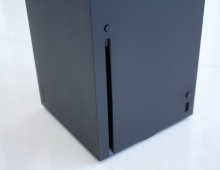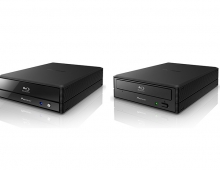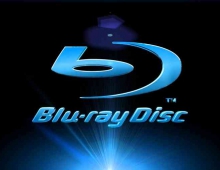
DEG Numbers Indicate Healthy Growth For Blu-ray
The Blu-ray disc format is five years old now and in spite of
streaming "threat," the latest sales figures released by the industry
organization Digital Entertainment Group (DEG) indicate that the
format is actually doing well.
Blu-ray Disc playback devices -including set-top box and game
consoles -sold through more than 28.5 million units since launch,
according to data released by DEG at CES 2011. Some six million
devices sold in the fourth quarter alone, bringing total units sold
to 11.25 million in calendar 2010, according to numbers compiled by
the DEG with input from retail tracking sources.
In addition and according to figures compiled by Swicker & Associates on behalf of the DEG, in calendar 2010, more than 170 million Blu-ray Discs shipped to market. In the fourth quarter, some 73 million discs shipped to retail. Since launch, nearly 350 million Blu-ray Discs have shipped. In the fourth quarter, nearly 343 million DVDs shipped to retail. More than one billion DVD units shipped throughout 2010 and more than 12.5 billion discs have shipped since the DVD format launched in 1997, DEG said.
In addition, an estimated 20.2 million DVD players were sold to U.S. consumers in 2010, according to figures compiled by the DEG based on data from Consumer Electronics Association (CEA) retailers and manufacturers. Since launch in spring 1997, some 297 million DVD players, including set-top and portable DVD players, Home-Theater-in-a-Box systems, TV/DVD and DVD/VCR combination players, have sold to consumers, bringing the number of DVD households to approximately 90 million (adjusting for households with more than one player). The DEG estimates that 70 percent of DVD owners have more than one player.
The 2010 home entertainment market continued to be bolstered by the steady growth of Blu-ray as total U.S. home entertainment spending hit $18.8 billion to close the year. Blu-ray software sales rose 68 percent in 2010, while consumer spending on digital distribution grew 19 percent, making a notable contribution to the overall home entertainment mix, according to DEG.
With input from all major motion picture studios, consumer electronics manufacturers, IT companies and tracking sources, DEG said that while overall consumer spending was down 3.3 percent for the year, Blu-ray continued its remarkable growth, with software sales of $1.8 billion. On the rental front, despite challenging market conditions, Blu-ray was up 34 percent in brick and mortar outlets. The DEG estimates that the number of Blu-ray playback devices in U.S. households soared to 27.5 million in 2010, up 62 percent.
"We continued to see strong growth in Blu-ray and significant gains in digital distribution this year, despite a tough economy," said Ron Sanders, President, DEG and President, Warner Home Video. "We also saw a slight increase in consumer transactions, which is a clear indication that consumer demand for home entertainment remains healthy."
Commenting on DEG's figures, Blu-ray Disc Association president Andy Parsons notes that Blu-ray is doing better than DVD before it. "If you look at the adoption rate of the market we could sell into, almost everyone could buy a DVD, be it a PlayStation 2 or standalone DVD, because everyone had an SDTV," says Parsons. "Blu-ray was selling the same number of units as DVDs, but it was doing so into less than half the market size, because not everyone had an HDTV yet. So that really means the adoption rate has picked up much faster than DVD."
The addition of streaming services-everything from Netflix to Vudu, Pandora, YouTube, Picasa, Flickr, and beyond to Blu-ray players has also helped the establishment of Blu-ray's position in the living room. However, can Blu-ray continue its growth when faced with the threat posed by the convenience of the same streaming services? The answer is not easy. For sure, as long as the content HD streaming experience depends on - not always high bandwidth - internet connections and there is prospect of tiered pricing and bandwidth throttling from Internet service providers, Blu-ray remains the best high-definition audio-visual experience in the home.
Regarding the Blu-ray disc format as an optical medium, it has not managed to become an essential element of the PC and laptop products. Most currently available high-end notebooks and PCs come with Blu-ray readers and not BD burners.
ULTRAVIOLET Design completed - Managed Copy becomes irrelevant?
At CES 2011, Digital Entertainment Content Ecosystem (DECE), unveiled a roadmap for introducing UltraViolet content, services and devices to consumers. Available in mid-2011, UltraViolet will most probably put aside BDA's plans to make the much-talked-about "Managed copy" feature available to Blu-ray disc releases. Managed Copy would have allowed digital copies and rights management using the Advanced Access Content System (AACS) DRM used by Blu-ray.
Six studios partnering on UltraViolet, which will allow consumers to purchase digital content and watch it wherever, whenever. According to DECE, consumers who purchase UltraViolet entertainment will have an easy way to watch film and television content across multiple branded platforms, such as computers, connected TVs, game consoles, smartphones and tablets. The UltraViolet name and logo will help identify content, devices and services from a spectrum of familiar entities ? including studios, retailers, consumer electronics manufacturers, cable companies, ISPs and other service providers that will work together.
Through the UltraViolet Account system, each household will be able to create an account for up to six members who can access the household?s UltraViolet movies, TV and other entertainment via participating retailers, streaming providers and devices. Consumers will also be able to register up to 12 devices so UltraViolet content can be downloaded to those devices, or shared among them. In addition to these UltraViolet devices, UltraViolet streaming access will enable consumers to access their collections via set-top boxes and most places they can access the web, via computers, web-connected home video devices such as Blu-ray players and Internet TVs, and mobile apps for smartphones and tablets. Also, the UltraViolet Account will enable retailers to provide consumers with a copy to use on DVD players or other physical media, such as portable flash memory.
Beginning in mid-2011, DECE Member companies and other UltraViolet licensees are expected to introduce UltraViolet products and services. Initial offerings will gradually expand to include a slate of UltraViolet titles from studios for purchase through retailers, either electronically or as digital copies included with Blu-ray Disc or DVD purchases. Initially, UltraViolet retailers will enable consumers to use downloaded copies on many devices they already own. Additionally, initial streaming services will allow consumers to access their UltraViolet collections via websites or linked devices, like set-top boxes, Internet-connected Blu-ray Disc players, smartphones and tablets.
Later in 2011, UltraViolet-optimized media player apps will begin to roll out via software updates to PCs, game consoles and smart mobile devices that consumers already own, as well as on new devices for sale. In early 2012, the first designed-for-UltraViolet consumer electronics devices are expected to become available. These devices will be immediately compatible with UltraViolet; potential offerings include connected Blu-ray Disc players, set-top boxes, Internet TVs and other devices.
In addition and according to figures compiled by Swicker & Associates on behalf of the DEG, in calendar 2010, more than 170 million Blu-ray Discs shipped to market. In the fourth quarter, some 73 million discs shipped to retail. Since launch, nearly 350 million Blu-ray Discs have shipped. In the fourth quarter, nearly 343 million DVDs shipped to retail. More than one billion DVD units shipped throughout 2010 and more than 12.5 billion discs have shipped since the DVD format launched in 1997, DEG said.
In addition, an estimated 20.2 million DVD players were sold to U.S. consumers in 2010, according to figures compiled by the DEG based on data from Consumer Electronics Association (CEA) retailers and manufacturers. Since launch in spring 1997, some 297 million DVD players, including set-top and portable DVD players, Home-Theater-in-a-Box systems, TV/DVD and DVD/VCR combination players, have sold to consumers, bringing the number of DVD households to approximately 90 million (adjusting for households with more than one player). The DEG estimates that 70 percent of DVD owners have more than one player.
The 2010 home entertainment market continued to be bolstered by the steady growth of Blu-ray as total U.S. home entertainment spending hit $18.8 billion to close the year. Blu-ray software sales rose 68 percent in 2010, while consumer spending on digital distribution grew 19 percent, making a notable contribution to the overall home entertainment mix, according to DEG.
With input from all major motion picture studios, consumer electronics manufacturers, IT companies and tracking sources, DEG said that while overall consumer spending was down 3.3 percent for the year, Blu-ray continued its remarkable growth, with software sales of $1.8 billion. On the rental front, despite challenging market conditions, Blu-ray was up 34 percent in brick and mortar outlets. The DEG estimates that the number of Blu-ray playback devices in U.S. households soared to 27.5 million in 2010, up 62 percent.
"We continued to see strong growth in Blu-ray and significant gains in digital distribution this year, despite a tough economy," said Ron Sanders, President, DEG and President, Warner Home Video. "We also saw a slight increase in consumer transactions, which is a clear indication that consumer demand for home entertainment remains healthy."
Commenting on DEG's figures, Blu-ray Disc Association president Andy Parsons notes that Blu-ray is doing better than DVD before it. "If you look at the adoption rate of the market we could sell into, almost everyone could buy a DVD, be it a PlayStation 2 or standalone DVD, because everyone had an SDTV," says Parsons. "Blu-ray was selling the same number of units as DVDs, but it was doing so into less than half the market size, because not everyone had an HDTV yet. So that really means the adoption rate has picked up much faster than DVD."
The addition of streaming services-everything from Netflix to Vudu, Pandora, YouTube, Picasa, Flickr, and beyond to Blu-ray players has also helped the establishment of Blu-ray's position in the living room. However, can Blu-ray continue its growth when faced with the threat posed by the convenience of the same streaming services? The answer is not easy. For sure, as long as the content HD streaming experience depends on - not always high bandwidth - internet connections and there is prospect of tiered pricing and bandwidth throttling from Internet service providers, Blu-ray remains the best high-definition audio-visual experience in the home.
Regarding the Blu-ray disc format as an optical medium, it has not managed to become an essential element of the PC and laptop products. Most currently available high-end notebooks and PCs come with Blu-ray readers and not BD burners.
ULTRAVIOLET Design completed - Managed Copy becomes irrelevant?
At CES 2011, Digital Entertainment Content Ecosystem (DECE), unveiled a roadmap for introducing UltraViolet content, services and devices to consumers. Available in mid-2011, UltraViolet will most probably put aside BDA's plans to make the much-talked-about "Managed copy" feature available to Blu-ray disc releases. Managed Copy would have allowed digital copies and rights management using the Advanced Access Content System (AACS) DRM used by Blu-ray.
Six studios partnering on UltraViolet, which will allow consumers to purchase digital content and watch it wherever, whenever. According to DECE, consumers who purchase UltraViolet entertainment will have an easy way to watch film and television content across multiple branded platforms, such as computers, connected TVs, game consoles, smartphones and tablets. The UltraViolet name and logo will help identify content, devices and services from a spectrum of familiar entities ? including studios, retailers, consumer electronics manufacturers, cable companies, ISPs and other service providers that will work together.
Through the UltraViolet Account system, each household will be able to create an account for up to six members who can access the household?s UltraViolet movies, TV and other entertainment via participating retailers, streaming providers and devices. Consumers will also be able to register up to 12 devices so UltraViolet content can be downloaded to those devices, or shared among them. In addition to these UltraViolet devices, UltraViolet streaming access will enable consumers to access their collections via set-top boxes and most places they can access the web, via computers, web-connected home video devices such as Blu-ray players and Internet TVs, and mobile apps for smartphones and tablets. Also, the UltraViolet Account will enable retailers to provide consumers with a copy to use on DVD players or other physical media, such as portable flash memory.
Beginning in mid-2011, DECE Member companies and other UltraViolet licensees are expected to introduce UltraViolet products and services. Initial offerings will gradually expand to include a slate of UltraViolet titles from studios for purchase through retailers, either electronically or as digital copies included with Blu-ray Disc or DVD purchases. Initially, UltraViolet retailers will enable consumers to use downloaded copies on many devices they already own. Additionally, initial streaming services will allow consumers to access their UltraViolet collections via websites or linked devices, like set-top boxes, Internet-connected Blu-ray Disc players, smartphones and tablets.
Later in 2011, UltraViolet-optimized media player apps will begin to roll out via software updates to PCs, game consoles and smart mobile devices that consumers already own, as well as on new devices for sale. In early 2012, the first designed-for-UltraViolet consumer electronics devices are expected to become available. These devices will be immediately compatible with UltraViolet; potential offerings include connected Blu-ray Disc players, set-top boxes, Internet TVs and other devices.





















